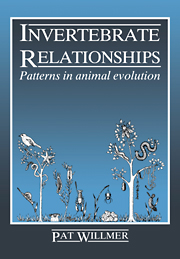Book contents
- Frontmatter
- Contents
- Acknowledgements
- Part I Introduction to animal phylogeny
- Part II Sources of evidence in invertebrate phylogeny
- 3 Evidence from the fossil record
- 4 Evidence from chemistry and genetics
- 5 Evidence from embryology and larvae
- 6 Evidence from cell ultrastructure
- Part III Phylogeny of major groups
- References
- Index
4 - Evidence from chemistry and genetics
Published online by Cambridge University Press: 08 January 2010
- Frontmatter
- Contents
- Acknowledgements
- Part I Introduction to animal phylogeny
- Part II Sources of evidence in invertebrate phylogeny
- 3 Evidence from the fossil record
- 4 Evidence from chemistry and genetics
- 5 Evidence from embryology and larvae
- 6 Evidence from cell ultrastructure
- Part III Phylogeny of major groups
- References
- Index
Summary
Introduction
In accordance with reductionist principles, molecular distributions and structures should be the most fundamental and ultimately satisfactory level at which evidence for phylogenetic relationships can be sought. The paradigm of modern biology requires that the base sequence of DNA determines the ultimate form and properties of the organism, as shown on page 51, even if it is not yet clear how this works at a developmental level. In an ideal world, then, a final taxonomy of the animal kingdom should be in terms of similarity and dissimilarity of this nucleic acid sequence, and it is the evidence available from genes, proteins and other chemical products that is considered in this chapter, leaving the processes of development for chapter 5.
In practice the field of molecular phylogeny is necessarily rather new, being largely dependent on techniques developed in the last forty years and vastly accelerated by those of the last decade. Indeed, this is an area where a genuine revolution has occurred; whereas the early and pioneering attempts to trace molecular history depended almost entirely on presence and absence criteria, there is now a new scientific discipline devoted to deciphering the threedimensional structures of proteins, the sequences of proteins and genes, and of the intervening DNA regions. Thus practical comparisons are now possible at the level of the essential make-up of the genetic material, and the rearrangements, deletions, insertions, and duplications of portions of nucleic acids as they have occurred through evolutionary history; and this is surely the most promising area for new insights into phylogeny in the near future.
- Type
- Chapter
- Information
- Invertebrate RelationshipsPatterns in Animal Evolution, pp. 77 - 99Publisher: Cambridge University PressPrint publication year: 1990



